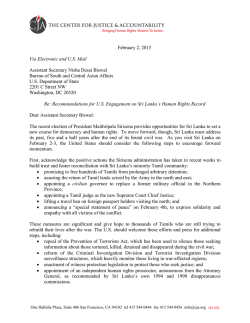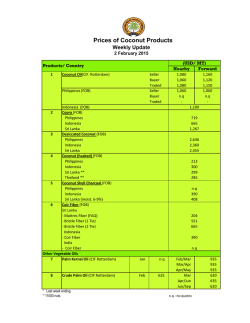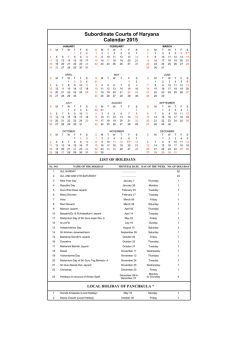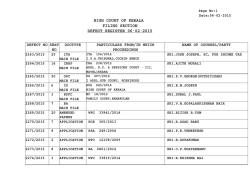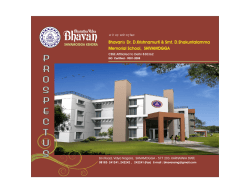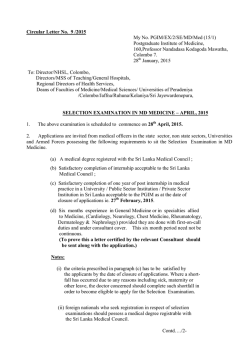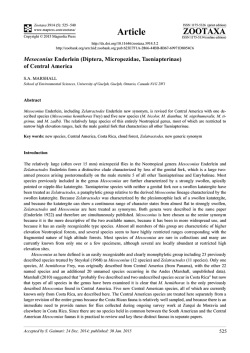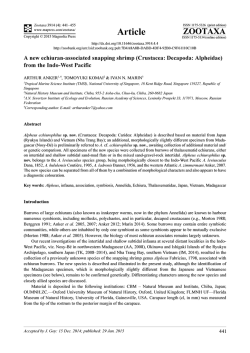
Preview - Magnolia Press
Zootaxa 3915 (1): 067–098 www.mapress.com /zootaxa / Copyright © 2015 Magnolia Press Article ISSN 1175-5326 (print edition) ZOOTAXA ISSN 1175-5334 (online edition) http://dx.doi.org/10.11646/zootaxa.3915.1.3 http://zoobank.org/urn:lsid:zoobank.org:pub:9717FBD7-EA26-4EDD-BBEA-5E2E22B11140 Two new species of the genus Sitana Cuvier, 1829 (Reptilia: Agamidae) from Sri Lanka, including a taxonomic revision of the Indian Sitana species A. A. THASUN AMARASINGHE1,6, IVAN INEICH2, D. M. S. SURANJAN KARUNARATHNA3, W. MADHAVA S. BOTEJUE4 & PATRICK D. CAMPBELL5 1 Research Center for Climate Change, University of Indonesia, Gd. PAU Lt. 8.5, Kampus UI, Depok 16424, Indonesia Muséum national d'Histoire naturelle, ISYEB (Institut de Systématique, Évolution et Biodiversité), UMR 7205 CNRS, EPHE, MNHN, UPMC, 57 rue Cuvier, CP 30 (Reptiles) – F-75005 Paris, France 3 Nature Explorations and Education Team, No: B-1 / G-6, De Soysapura Housing Scheme, Moratuwa 10400, Sri Lanka 4 Taprobanica Nature Conservation Society, 150/6, Stanley Thilakaratne Mawatha, Nugegoda, Sri Lanka 5 Department of Life Sciences, Darwin Centre, Natural History Museum, Cromwell Road, South Kensington, London SW7 5BD, England 6 Corresponding author. E-mail: [email protected] 2 Abstract The genus Sitana was described by Cuvier (1829) on the basis of a single species, S. ponticeriana. The secondly described, Sitana minor Günther, 1864, is identical to S. ponticeriana Cuvier, 1829, and should be considered as a junior objective synonym of the latter. The syntypes of S. deccanensis Jerdon, 1870 have been rediscovered, misplaced among the syntypes of S. minor (sensu Boulenger 1885) at the Natural History Museum (London) and the former taxon is here recognised as a valid species and redescribed. There is some doubt surrounding the taxon Sitana ponticeriana mucronata Deraniyagala, 1957. Its type is lost and no live populations have been found since its original description; therefore, we here consider this trinomen as a nomen dubium. The Sitana populations which are distributed in drier and warmer areas of the lower peneplain of Sri Lanka are sufficiently different from the known Indian species and are thus herein described as new species. The two new species, Sitana bahiri sp. nov. and Sitana devakai sp. nov., differ from mainland Indian congeners by having the following combination of characters: SVL 40.0–50.0 mm; axilla-dewlap length 28.3–32.5% of axilla-groin length; snout length 54.7–63.2% of head width; femur length 70.6–78.4% of tibia length; foot length 154.7–180.2% of head length; 49–59 midbody scales; 87–108 ventral scales; unequal and irregular lateral scales with intermediate enlarged scales; 7–9 supralabials; 14–17 subdigital lamellae on toe III; 21–26 subdigital lamellae on toe IV; enlarged scales above the tympanum; a single pale stripe from the snout up to the shoulder. Sitana bahiri sp. nov. differs from Sitana devakai sp. nov. by having ventrals 87–89 (vs. 100–108), mucronate lateral scales (vs. rounded) in males, and rounded (vs. mucronate) ventral scales in females, plus several other characters discussed later . The remaining Sitana populations in India seem to represent several undescribed species, but extensive field work and molecular studies are needed in order to obtain better knowledge. We believe this study, which provides descriptions for all the recognised Indian species, will go some way in stabilizing the nomenclature for this group of common agamid lizards. Key words: biogeography, fan-throated lizard, lectotype, Sitana ponticeriana, syntype, taxonomy Introduction The fan-throated lizard genus Sitana, was described by Cuvier (1829) on the basis of a single species, S. ponticeriana. Wagler (1830) erected a new genus, Semiophorus, and designated Sitana ponticeriana as its type species (spelled “pondiceriana”). Later, Wiegmann (1834) corrected the species name to the masculine gender as Semiophorus pondicerianus. Duméril & Bibron (1837) specified that Sitana ponticeriana’s name (Sitane de Pondichéry) was attributed by Cuvier (1829) since the first specimen received in the Muséum national d’Histoire naturelle, Paris, France (MNHN) was collected from Pondichéry (today Puducherry), India, sent by Leschenault. We accept that in doing this, they have implicitly restricted the type locality "Indes Orientales" to Pondichéry, and Accepted by S. Carranza: 19 Dec. 2014; published: 2 Feb. 2015 67 References Amarasinghe, A.A.T. & Bauer, A.M. (2009) On the holotype of Cnemaspis podihuna Deraniyagala, 1944. Taprobanica, 1, 80–82. Amarasinghe, A.A.T., Manthey, U., Stöckli, E., Ineich, I., Kullander, S.O., Tiedemann, F., McCarthy, C. & Gabadage, D.E. (2009) The original descriptions and figures of Sri Lankan Agamid Lizards (Squamata: Agamidae) of the 18th and 19th centuries. Taprobanica, 1, 2–15. Anders, C. & Kästle, W. (2002) Amphibians and Reptiles of Nepal – Lizards and Crocodiles. Koeltz Scientific Books, Königstein, 39 pp. [Schleich, H.H. & Kästle, W. (Eds.)] Bahir, M.M. & Silva, A. (2005) Otocryptis nigristigma, a new species of Agamid Lizard from Sri Lanka. In: Yeo, C.J., Ng P.K.L. & Pethiyagoda, R. (Ed.), Contributions to biodiversity exploration and research in Sri Lanka. The Raffles Bulletin of Zoology, 12 (Supplement), 393–406. Batuwita, S. & Pethiyagoda, R. (2007) Description of new species of Sri Lankan Litter Skink (Squamata: Scincidae: Lankascincus). Ceylon Journal of Science (Bio. Sci.), 36, 80–87. Bettany, G.T. (1885–1900) Hope, Frederick William. Dictionary of National Biography. Smith, Elder & Co., London, 313 pp. Bossuyt, F., Meegaskumbura, M., Beenaerts, N., Gower, D.J., Pethiyagoda, R., Roelants, K,, Mannaert, A., Wilkinson, M., Bahir, M.M., Manamendra-Arachchi, K., Ng, P.K.L., Schneider, C.J., Oommen, O.V. & Milinkovitch, M.C. (2004) Local endemism within the Western Ghats – Sri Lanka Biodiversity Hotspot. Science, 306, 479–481. http://dx.doi.org/10.1126/science.1100167 Boulenger, G.A. (1885) Catalogue of the Lizards in the British Museum. 2nd Edition. Vol. 1. London, 436 pp. Brygoo, E.R. (1988) Les types d’Agamidés (Reptiles, Sauriens) du Muséum national d’Histoire naturelle. Catalogue critique. Bulletin du Muséum national d’Histoire naturelle, Séries 4è, Section A, 10 (3), supplement, 1–56. Chisholm, H. (1911) Blanford, William Thomas. In: Encyclopædia Britannica. 11th Edition. Vol. 4. Cambridge University Press, Cambridge. [page number unkown] Cuvier, G. (1829) Le Règne animal distribué d'après son organisation, pour servir de base a l'histoire naturelle des animaux et d'introduction a l'anatomie comparée. Nouvelle édition (2nd Edition), revue et augmentée, Tome II. Déterville & Crochard, Paris, xvi + 406 pp. Das, I. (1996) Biogeography of the Reptiles of South Asia. Krieger Publishing Company, Malabar, Florida, 87 pp. Das, I. (2010) A Field Guide to the Reptiles of South-East Asia. New Holland Publishers Ltd. UK, 376 pp. Das, I. & de Silva, A. (2005) A Photographic guide to the Snakes and other Reptiles of Sri Lanka. New Holland Publishers, 144pp. Das, I., Dattagupta, B. & Gayen, N.C. (1998) History and catalogue of reptile types in the collection of the Zoological Survey of India. Journal of South Asian Natural History, 3, 1–52. Deraniyagala, P.E.P. (1944) A new Cnemaspis gecko from Ceylon. Journal of Royal Asiatic Society (Ceylon Branch), 36, 222–227. Deraniyagala, P.E.P. (1953) A Colored Atlas of some vertebrates from Ceylon, Tetrapod Reptilia. Vol. 2. National Museums of Sri Lanka, Colombo, 101 pp. Deraniyagala, P.E.P. (1957) Ceylon Administration Reports, part IV: Education Science and Art Sections of the National Museum of Sri Lanka. Ceylon Government press, Colombo, E4–E5. Deshpande, V.Y., Sidharth, K.D.M.K. & Mahamuni, H.R. (2012) Reptilian Fauna of Khandala Tahsil, Maharashtra. Advances in Applied Science Research, 3, 735–737. de Silva, A. (2006) Current status of the Reptiles of Sri Lanka. In: Bambaradeniya, C.N.B. (Ed.). Fauna of Sri Lanka: Status of Taxonomy, Research and Conservation, IUCN Sri Lanka, Colombo, 134–163 pp. Duméril, A.M.C. & Bibron, G. (1837) Erpétologie générale ou histoire naturelle complète des reptiles. Tome quatrième. Librairie encyclopédique de Roret, Paris, 571 pp. Duvernoy, L.G. (1846) Atlas (Les reptiles). Le Règne animal distribué d'après son organisation, pour servir de base à l'histoire naturelle des animaux et d'introduction a l'anatomie comparée, plate 16. Elliot, W. (1876) Memoir of Dr T. C. Jerdon. In: History of the Berwickshire Naturalists’ Club. Henry Hunter Blair, Market Place 7, pp. 143–151. Erdelen, W. (1998) The genera Otocryptis and Sitana: Geographic distribution, microhabitat use and morphometric relations. In: Biology and Conservation of the Amphibians, Reptiles and their habitats in South Asia. Proceedings of the International Conference on the Biology and Conservation of the Amphibians and Reptiles of South Asia, Sri Lanka, pp. 232–246. Günther, A.C.L.G. (1864) The Reptiles of British India. The Ray Society, London, 452 pp. Guptha, M.B., Rao, P.V.C., Prasad, N.V.S., Maddala, S.R.S.C.S., Babu, P.M. & Reddy, D.S. (2012) Status of Herpetofauna in Seshachalam Biosphere Reserve, Eastern Ghats, Andhra Pradesh, India. World Journal of Zoology, 7, 131–134. Helgen, K.M. & Groves, C.P. (2005) Biodiversity in Sri Lanka and Western Ghats. Science, 308, 199. http://dx.doi.org/10.1126/science.308.5719.199b IUCN Standards and Petitions Subcommittee. (2013) Guidelines for Using the IUCN Red List Categories and Criteria. Version 10.1. Prepared by the Standards and Petitions Subcommittee, UK, 85 pp. Jerdon T.C. (1853) Catalogue of the reptiles inhabiting the peninsula of India. Journal of Asiatic Society Bengal, 22, 462–479. 96 · Zootaxa 3915 (1) © 2015 Magnolia Press AMARASINGHE ET AL. Jerdon, T.C. (1870) Notes on Indian Herpetology. Proceedings of the Asiatic Society Bengal, 1870, 66–85. Karunarathna, D.M.S.S. & Amarasinghe, A.A.T. (2008) Notes on the territorial behaviour of Otocryptis wiegmanni Wagler, 1830 (Reptilia: Agamidae: Draconinae). Herpetotropicos, 4, 79–83. Kelaart, E.F. (1854) Catalogue of reptiles collected in Ceylon. Annals and Magazine of Natural History, 2 (XIII), 137–140. http://dx.doi.org/10.1080/03745485709495092 Lancaster, R. (2013) “Bringing back the birch”. The Garden (Royal Horticultural Society), 138 pp. Macey, J.R., II Schulte, J.A., Larson, A., Ananjeva, N.B., Wang, Y., Pethiyagoda, R., Rasteger-Pouyani, N., Papenfuss, T.J. (2000) Evaluating trans-Tethys migration: an example using Acrodont lizard phylogenetics. Systematic Biology, 49, 233–256. http://dx.doi.org/10.1093/sysbio/49.2.233 Manamendra-Arachchi, K. & Liyanage, S. (1994) Conservation and distributions of the agamid lizards of Sri Lanka with illustrations of the extant species. Journal of South Asian Natural History, 1, 77–96. Manamendra-Arachchi, K. & Pethiyagoda, R. (2005) The Sri Lankan shrub frogs of the genus Philautus Gistel, 1848 (Ranidae: Rhacophorinae), with description of 27 new species. In: Yeo C.J., Ng P.K.L. & Pethiyagoda, R. (Ed.), Contributions to biodiversity exploration and research in Sri Lanka. The Raffles Bulletin of Zoology, 12 (Supplement), 163–303. Manthey, U. (2010) Agamid Lizards of Southern Asia, Draconinae 2 & Leiolepidinae. Edition Chimaira & A.C.S. Glaser, Germany, Frankfurt am Main, 168 pp. Moody, S.M. (1980) Phylogenetic and historical biogeographical relationships of the genera in the family Agamidae (Reptilia: Lacertilia). PhD thesis, Michigan, University of Michigan, USA. [page number unkown] Moore, T. (2004) Blanford, William Thomas (1832–1905). Oxford Dictionary of National Biography. May 2007. Oxford University Press. [online edition] Nair, T. & Krishna, C. (2013) Vertebrate fauna of the Chambal River Basin, with emphasis on the National Chambal Sanctuary, India. Journal of Threatened Taxa, 5, 3620–3641. http://dx.doi.org/10.11609/JoTT.o3238.3620-41 Ohler, A.-M. & Deuti, K. (2013) Pyxicephalus khasianus Anderson, 1871 and Rana laticeps Boulenger, 1882 (Dicroglossidae, Anura, Amphibia) are synonyms. Zoosystema, 35, 415–424. http://dx.doi.org/10.5252/z2013n3a4 Pal, A., Swain, M.M. & Rath, S. (2007) Seasonal variation in the diet of the fan-throated lizard, Sitana ponticeriana (Sauria: Agamidae). Herpetological Conservation and Biology, 2, 145–148. Pal, A., Swain, M.M. & Rath, S. (2011) Reproduction and sexual dichromatism in Sitana ponticeriana (Reptilia: Draconinae: Agamidae). Taprobanica, 3, 31–37. http://dx.doi.org/10.4038/tapro.v3i1.3231 Patankar, P., Desai, I., Trivedi, J.N. & Balakrishnan, S. (2013) Ethogram of courtship and mating behaviour of Sitana cf. ponticeriana (Reptilia: Draconinae: Agamidae) in India. Taprobanica, 5, 44–49. http://dx.doi.org/10.4038/tapro.v5i1.5661 Pethiyagoda, R., Meegaskumbura, M. & Maduwage, K. (2012) A synopsis of the South Asian fishes referred to Puntius (Pisces: Cyprinidae). Ichthyological Exploration of Freshwaters, 23, 69–95. Pyron, R.A., Burbrink, F.T. & Wiens, J.J. (2013) A phylogeny and revised classification of Squamata, including 4161 species of lizards and snakes. BMC Evolutionary Biology, 13, 1–53. http://dx.doi.org/10.1186/1471-2148-13-93 Ramesh, T., Hussain, K.J., Satpathy, K.K. & Selvanayagam, M. (2013) Community composition and distribution of herpetofauna at Kalpakkam Nuclear campus, Southern India. Herpetology Notes, 6, 343–351. Reddy, Y.A., Sadasivaiah, B., Indira, P. & Pullaiah, T. (2013) Herpetofauna of Thummalapalle uranium mining area, Andhra Pradesh, India. International Journal of Biodiversity and Conservation Action, 5, 515–522. Sabaj Pérez, M.H. (ed.) 2014. Standard Symbolic Codes for Institutional Resource Collections in Herpetology and Ichthyology: An Online Reference, verson 5.0 (22 September 2014). American Society of Ichthyologists & Herpetologists, Washington, DC. Schleich, H.H. & Kästle, W. (1998) Sitana fusca spec. nov., a further species from the Sitana sivalensis complex. Veröffentlichungen aus dem Fuhlrott-Museum, 4, 207–226. Schleich, H.H., Kästle, W. & Shah, K.B. (1998) Description of Sitana sivalensis spec. nov. from south Nepal. Veröffentlichungen aus dem Fuhlrott-Museum, 4, 87–100. Shanbhag, B.A., Radder, R.S., Gramapurohit, N.P., Dheeraj, K.V., Ammanna, V.H., Pandav, B.N. & Saidapur, S.K. (2003) Demography of fan-throated lizard, Sitana ponticeriana (Cuvier) in a cotton field in Dharwad district of Karnataka state, India. Current Science, 85, 1363–1366. Simon, E. (1905) Voyage de M. Maurice Maindron dans l'Inde méridionale (mai à novembre 1901), 7ème Mémoire. Arachnides (1re partie). In: Annales de la Société entomologique de France, 74, 160–180. Smith, A.Z. (1986) A history of the Hope Entomological Collections in the University Museum Oxford with lists of archives and collections. Clarendon Press Oxford, 172 pp. Smith, M.A. (1935) The fauna of British India including Ceylon and Burma, Reptilia and Amphibia - Vol II Sauria, London, 440 pp. Somaweera, R. & Somaweera, N. (2009) Lizards of Sri Lanka: A colour guide with field keys. Edition Chimaira, Frankfurt/ TWO NEW SPECIES OF THE GENUS SITANA FROM SRI LANKA Zootaxa 3915 (1) © 2015 Magnolia Press · 97 Main, Germany, 303 pp. Taylor, E.H. (1953) A review of the lizards of Ceylon, The University of Kansas Science Bulletin, 35, 1525–1585. Trivedi, J.N., Bayani, A.S., Pratyush, P. & Suresh, B. (2013) Study of Egg-Laying Behaviour of Fan-throated Lizard, Sitana ponticeriana (sic) (Cuvier, 1829) from Shrubland of Vadodara City, Gujarat, India. International Research Journal of Biological Sciences, 2, 74–77. Tsetan, C. & Ramanibai, R. (2011) Reptilian fauna of agricultural landscapes of Chembarambakkam Lake, Chennai, Tamil Nadu. Reptile Rap, 13, 2–8. Wagler, J. (1830) Natürliches System der Amphibien, mit vorangehender Classification der Saügethiere und Vögel. Ein Beitrag zur vergleichenden Zoologie. J. G. Cotta’schen Buchhandlung, München, Stuttgart and Tübingen, 354 pp. http://dx.doi.org/10.5962/bhl.title.58730 Watve, A. (2013) Status review of Rocky plateaus in the northern Western Ghats and Konkan region of Maharashtra, India with recommendations for conservation and management. Journal of Threatened Taxa, 5, 3935–3962. http://dx.doi.org/10.11609/JoTT.o3372.3935-62 Wermuth, H. (1967) Liste der rezenten Amphibien und Reptilien. Agamidae. Das Tierreich, 86. Walter de Gruyter, Berlin, 127 pp. Wiegmann, A.F.A. (1834) Herpetologia Mexicana, seu descriptio amphibiorum novae hispaniae, quae itineribus comitis de Sack, Ferdinandi Deppe et Chr. Guil. Schiede im Museum Zoologicum Berolinense Pervenerunt. Pars prima, saurorum species. Berlin, Lüderitz, 54 pp. APPENDIX I. Additional specimens examined. Sitana cf. devakai. Male, (ZSI/SRS 188), SVL 43.0 mm, Thirunelveli, Tamil Nadu, India; Male, (ZSI/SRS 358) SVL 53.9 mm, Thirunelveli, Tamil Nadu, India; Male, (ZSI/SRS 227), SVL 42.4mm, Pudukottai, Tamil Nadu, India. Sitana cf. ponticeriana. Male, (ZSI 5051), SVL 43.4mm; Male (ZSI 5052), SVL 40.4mm; Male (ZSI 5053), SVL 39.6mm; all from south-eastern Berar & Chanda (north-eastern India); Male (ZSI 22720A) SVL 48.6mm; Male (ZSI 22720B), SVL 49.3mm; Male (ZSI 22720C), SVL 44.7mm; Male (ZSI 22720D) SVL 44.7mm; Male (ZSI 22720E) SVL 46.7mm; all from Orissa, India. See the following corresponding figure in Manthey (2010): RA04162-4 (page 153). Sitana deccanensis. Male, (BNHM 261), SVL 66 mm; Male, (BNHM 267), SVL 65 mm; Male, (BNHM 268), SVL 63 mm; all from Maharashtra, India. Otocryptis wiegmanni. Male, (ZMB 708), SVL 60.0mm (holotype of Otocryptis bivittata, see Amarasinghe et al., 2009; Bahir & Silva, 2005); Male, (WHT 1496) SVL 48.9mm, Haycock near Hiniduma (Galle), Sri Lanka. 98 · Zootaxa 3915 (1) © 2015 Magnolia Press AMARASINGHE ET AL.
© Copyright 2025
